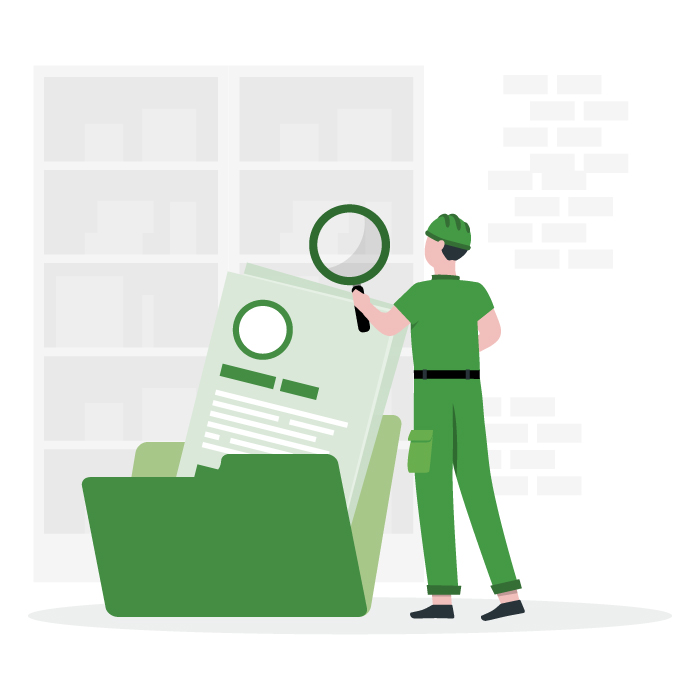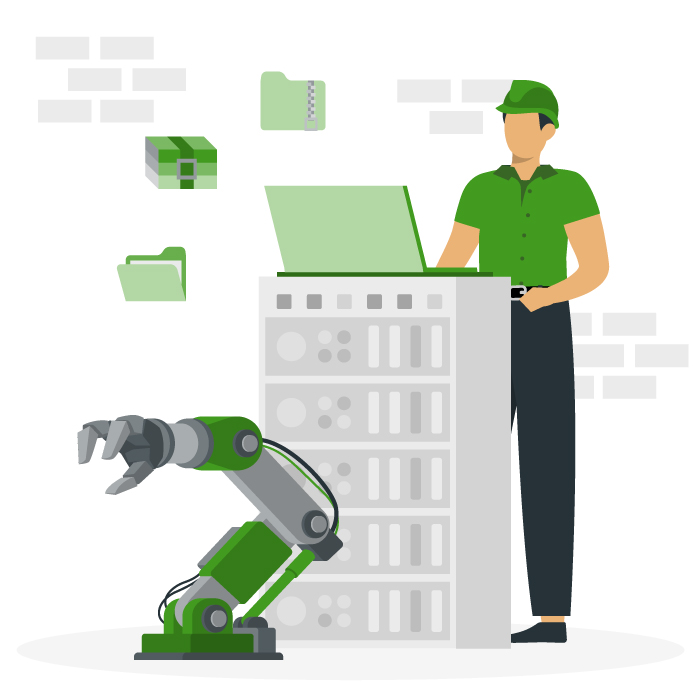Enterprise Asset Management (EAM)
Enterprise Asset Management software helps organizations track, maintain, and optimize assets across their entire lifecycle. This guide breaks down what EAM is, how it differs from CMMS, and the tools, benefits, and strategies that power smarter asset management at scale.
What is Enterprise Asset Management (EAM)?
Enterprise Asset Management (EAM) is the system and strategy organizations use to monitor, maintain, and optimize physical assets across their entire lifecycle—from acquisition and operation to repair and disposal. Its goal is to maximize asset performance, extend useful life, and reduce downtime and maintenance costs.
EAM involves structured maintenance programs, centralized asset data, and tools to manage work orders, inventory, compliance, and performance analytics. Modern EAM software replaces spreadsheets and manual processes with a consistent, data-driven approach.
By adopting EAM, organizations move from reactive fixes to a proactive, strategic maintenance model that keeps critical assets running reliably.
What is the difference between EAM & CMMS?
If you’re familiar with maintenance management tools, you may be wondering about EAM vs CMMS. A CMMS is a Computerized Maintenance Management System – a software solution focused on streamlining maintenance activities. Both EAM and CMMS software are used to improve asset uptime and maintenance efficiency, but there are important differences in their scope and capabilities:
- Scope of Asset Management: A CMMS focuses on the maintenance phase—scheduling work, tracking repairs, and managing preventive tasks. EAM covers the full asset lifecycle, from acquisition to decommissioning, and includes broader functions like procurement, depreciation tracking, and end-of-life planning.
- Features & Functionality: Because of the scope difference, EAM systems typically include a wider range of modules such as asset lifecycle planning, asset performance analysis, contract management, warranty management, procurement and purchasing, and even integrations to financial systems for tracking asset costs. Modern CMMS software like Limble is also capable of similar asset management and integration with other financial systems that enable a holistic view of your operations.
- Organizational Use Cases: CMMS software is ideal for maintenance teams managing daily work orders and asset upkeep. It’s simple, cost-effective, and quick to implement. EAM software, on the other hand, serves asset-intensive organizations needing enterprise-wide asset visibility and integration with systems like ERP or supply chain management tools. For smaller operations, a CMMS often offers enough functionality without the complexity of a full EAM system.
- Integration & Business Processes: EAM systems often integrate with ERP, HR, and financial tools to manage asset lifecycle and operational costs across departments. While CMMS solutions can also integrate with tools like IoT or procurement software, these connections are typically more essential in EAM setups. EAM supports multiple departments, while CMMS primarily serves maintenance teams.
EAM vs CMMS Comparison Table
| CMMS | EAM | |
|---|---|---|
| Scope | Focuses on the maintenance phase of an asset’s lifecycle (scheduling, tracking, repairs). | Covers the entire asset lifecycle—from acquisition and operation to disposal. |
| Functionality | Work order management, preventive maintenance, basic inventory tracking. | Includes CMMS features plus asset lifecycle planning, procurement, warranty, and performance tracking. |
| Typical Users | Maintenance teams at small to mid-sized businesses or single facilities. | Large, asset-intensive organizations with enterprise-wide visibility needs. |
| Integration | Can integrate with other systems but typically focused on maintenance operations. | Designed for cross-department integration (ERP, HR, finance, supply chain). |
| Strategic Role | Tactical tool focused on executing maintenance activities efficiently. | Strategic platform used for long-term asset planning and enterprise decision-making. |
It’s worth noting that the line between EAM and CMMS is not always rigid. Many advanced CMMS solutions today offer expanded functionality that approaches EAM capabilities, and conversely, some EAM suites include robust CMMS modules for maintenance management. In fact, some large organizations use both: they might deploy a broad EAM system for asset planning and financial tracking, while the maintenance team uses the CMMS component of that system (or a separate integrated CMMS) for the day-to-day work.
The key distinction is that EAM presents a holistic, strategic view of assets across the enterprise, whereas CMMS provides a tactical toolset to manage ongoing maintenance. Understanding these differences can help a company determine whether they need a full EAM solution or if a CMMS will cover their requirements (or whether a combination makes sense).
Common components & unique features of an EAM system
Modern EAM systems are built to manage every aspect of asset performance, blending powerful maintenance tools with strategic lifecycle management. While many features overlap with advanced CMMS software, EAM platforms go a step further—integrating deeper into organizational planning and compliance.
Features Shared by EAM & CMMS
- Asset Inventory & Tracking: At the heart of EAM is a centralized asset registry that catalogs all of the organization’s physical assets – including details like asset IDs, location, manufacturer, purchase date, warranty information, and more. EAM systems often support asset tracking technologies (e.g. barcode/QR code scanning, RFID tags, or GPS trackers) to monitor asset location and status in real time.
- Work Order Management: EAM software offers robust work order management to streamline maintenance from request to completion. Users can create, assign, schedule, and track tasks, with automation for recurring preventive work. Features like prioritization, mobile notifications, and full asset history help ensure nothing slips through the cracks.
- Preventive Maintenance Scheduling: Managing preventive maintenance by scheduling maintenance tasks like inspections and part replacements based on best practices and historical data. The system automates reminders and work orders, helping teams shift from reactive to proactive maintenance and reduce unexpected failures.
- Predictive Maintenance & Condition Monitoring: Many EAM systems support predictive maintenance by integrating with condition monitoring tools and IoT sensors that track real-time asset data. When abnormal patterns or thresholds are detected, the system can trigger alerts or work orders—allowing teams to address issues before failures occur. This data-driven approach helps optimize maintenance timing and reduce unplanned downtime.
- Asset Performance Monitoring & Analytics: EAM goes beyond maintenance scheduling by continuously tracking asset performance through KPIs like uptime, MTBF, and maintenance costs. Dashboards and analytics help teams spot trends, identify issues, and optimize strategies. Advanced tools (often called Asset Performance Management) can even uncover root causes and recommend improvements—giving decision-makers clear insights to prioritize resources and boost asset reliability.
- Spare Parts & Inventory Management: EAM systems often include inventory management to track spare parts, manage stock levels, and automate reordering. This ensures parts are available when needed, avoids stockouts or overstocking, and links parts usage to specific work orders—helping control costs and streamline maintenance.
- Integration with Other Systems: EAM systems often integrate with tools like ERP, accounting, IoT platforms, and CMMS to ensure seamless data sharing. These connections help sync asset and financial data, automate updates, and enable real-time condition monitoring. With APIs and built-in connectors, EAM becomes part of a cohesive IT ecosystem—streamlining workflows and improving data accuracy across departments.
| Shared Feature | Description |
|---|---|
| Asset Inventory & Tracking | Centralized asset registry with details like ID, location, warranty, and real-time tracking using QR, RFID, or GPS. |
| Work Order Management | Create, assign, and track work orders with automation, prioritization, mobile access, and full history logging. |
| Preventive Maintenance Scheduling | Schedule routine tasks using OEM guidelines and automate work orders to reduce breakdowns. |
| Predictive Maintenance | Uses IoT sensors and condition monitoring to trigger alerts and work orders before failures occur. |
| Asset Performance Monitoring | Track KPIs like uptime and MTBF, run advanced analytics, and identify trends for continuous improvement. |
| Spare Parts & Inventory | Manage stock levels, automate reordering, and link parts to work orders for cost tracking and efficiency. |
| System Integrations | Connects with ERP, accounting, and IoT platforms to sync asset and financial data across systems. |
Features unique to EAM software
- Track Asset Lifecycle & Capital Planning: A unique feature of EAM is asset lifecycle management. It helps plan each stage—from procurement to disposal—by tracking total cost of ownership and performance over time. The system can flag when assets near end-of-life or become too costly to maintain, supporting smarter replacement decisions and long-term capital planning. EAM treats assets as investments, not just equipment to fix.
- Compliance & Safety Management: EAM software supports regulatory compliance by tracking maintenance requirements, scheduling inspections, and documenting safety actions. It can manage permits, attach safety procedures to work orders, and log incidents or audits—helping organizations meet legal standards and reduce risk while improving workplace safety. Limble is the only CMMS software built from the ground up to be 21 CFR compliant compared to other CMMS software.
| Exclusive EAM Feature | Why It Matters |
|---|---|
| Asset Lifecycle & Capital Planning | Plans the full asset lifecycle—from procurement to disposal—tracking cost, performance, and helping with smarter replacement decisions. |
| Compliance & Safety Management | Schedules inspections, manages permits, and logs safety actions to ensure regulatory compliance and reduce risk. Limble is uniquely built for 21 CFR compliance compared to other CMMS providers. |
These core features highlight the foundation of a strong enterprise asset management strategy—but a robust EAM system often goes further. Many solutions also support vendor management, technician certifications, and other specialized functions. By centralizing everything in one platform, an asset maintenance management program becomes more efficient, eliminating the need for disconnected spreadsheets or tools. The result is a streamlined, data-driven approach to managing assets across their entire lifecycle.
Benefits of implementing EAM (Why is Enterprise Asset Management important)
Implementing a robust EAM strategy and system can deliver significant value. Enterprise asset management is important because it creates a structured, optimized approach to caring for assets, which in turn yields numerous operational and financial management benefits. Below are just some example of key benefits of EAM and why it is so important for organizations:
- Higher asset reliability & uptime: reduces unplanned downtime by keeping maintenance on schedule through preventive and predictive strategies—leading to more consistent operations, fewer disruptions, and increased productivity.
- Extended asset lifespan: extends asset life by ensuring timely maintenance and avoiding run-to-failure scenarios. This delays costly replacements and maximizes ROI over time.
- Lower maintenance & repair costs: reduces expenses by enabling preventive maintenance, avoiding costly emergency repairs, minimizing overtime and rush orders, and helping teams identify when assets are no longer worth fixing—all contributing to stronger ROI.
- Improved maintenance efficiency & productivity: streamlines workflows with prioritized work orders, clear procedures, and mobile access—reducing paperwork and boosting technician productivity. This leads to faster repairs, fewer delays, and smoother operations across departments.
- Optimized inventory & resource management: Avoid part shortages and overstock by tracking usage and forecasting needs. It also supports smarter labor planning—ensuring materials, tools, and staffing are used efficiently to cut waste and save costs.
- Regulatory compliance & safety assurance: EAM helps ensure regulatory compliance by automating inspections, calibrations, and documentation. It creates audit trails, enforces safety protocols like lockout/tagout, and keeps equipment in safe, working condition—reducing risk, protecting workers, and avoiding costly penalties.
- Centralized information & better communication: EAM provides a single source of truth for all stakeholders, improving cross-department collaboration and decision-making. Everyone—from maintenance to finance—can access real-time asset data, reducing confusion and ensuring smoother operations.
Enterprise asset management is important because it drives operational efficiency for any business that depends on physical assets. By implementing EAM, companies can save money, avoid downtime, extend the life of their equipment, keep workers safe, and make smarter decisions about assets – all of which contribute to a more reliable and cost-effective operation.
Which industries use EAM?
EAM originated in industries with expensive, complex assets, and today it is used widely in asset-intensive industries where maximizing asset performance and lifespan is critical to business success. If an organization has a lot of physical assets or infrastructure to keep track of, there’s a good chance EAM can play a valuable role. Here are some industries that commonly use EAM solutions:
- Manufacturing: EAM helps manufacturers reduce downtime, manage spare parts, and maintain critical equipment through preventive maintenance. This supports higher productivity, faster repairs, and improved OEE across production lines.
- Healthcare: EAM ensures critical medical and facility equipment is properly maintained, supporting patient safety and strict compliance. It helps healthcare teams track inspections, calibrations, and maintenance logs—minimizing risk in high-stakes environments.
- Transportation & Logistics: EAM supports fleet and equipment maintenance by scheduling services, tracking usage, and managing parts. It helps reduce downtime, optimize vehicle performance, and keep logistics operations running smoothly.
- Energy & Utilities (including Oil & Gas): EAM is essential for managing complex infrastructure in power, water, and oil & gas. It helps prevent costly outages, ensures safety and environmental compliance, and coordinates maintenance across widespread assets—boosting reliability and risk management.
- Government and Public Sector: Government agencies use EAM to manage infrastructure like roads, buildings, and fleets. It improves maintenance planning, supports safety and budgeting, and helps extend asset life—leading to cost savings and better public service delivery.
EAM began in asset-heavy industries but is now used across sectors where uptime, safety, and cost control matter. From manufacturing and healthcare to energy, logistics, and government, EAM helps reduce downtime, extend asset life, and improve planning. It’s just as effective for facilities, education, and other infrastructure-reliant operations. Wherever assets need to be maintained efficiently, EAM brings the data, structure, and visibility to make it happen.
Software solutions & tech commonly used for EAM
Implementing enterprise asset management requires more than just strategy—it depends on the right tools. Modern EAM software brings together everything from asset tracking to maintenance scheduling and performance analysis. To get the most value, organizations must consider how the software is deployed, how well it integrates with existing systems, and how it leverages emerging technologies to support smarter maintenance.
Cloud vs. On-Premise EAM
Cloud-based EAM has become the preferred choice for many businesses due to its flexibility, scalability, and lower upfront costs. These systems are hosted by the vendor and accessed via browser or mobile app, with automatic updates and minimal IT maintenance. They’re ideal for teams needing remote access or lacking in-house infrastructure.
On-premise EAM is still used by organizations with strict data control or uptime requirements. Installed on internal servers, these systems allow deeper customization but come with higher upfront costs and require dedicated IT resources for maintenance and upgrades. Hybrid models—private cloud deployments—offer a middle ground.
Key takeaway: Cloud-based EAM offers speed, accessibility, and scalability, while on-premise suits those with complex security or customization needs.
Mobile workforce management
Modern EAM systems come equipped with mobile apps that support technicians in the field. These apps allow real-time work order updates, asset lookups, meter readings, and documentation—all from a mobile device. Mobile access boosts productivity, reduces delays, and improves data accuracy, even in offline environments.
System integrations
EAM software is designed to connect with other business systems, enabling seamless data exchange. Common integrations include:
- Enterprise Resource Planning (ERP) for syncing procurement, inventory, and financial data
- Accounting & fixed-asset tools to update asset book values and costs
- SCADA, BMS, or IoT platforms for real-time condition monitoring
- Fleet, facility, or IT asset management systems for centralized oversight
With built-in APIs and connectors, EAM fits into broader tech ecosystems—streamlining workflows and eliminating data silos.
Emerging technologies shaping EAM
EAM systems are evolving quickly thanks to advancements in digital technology. Here are key innovations driving smarter asset management solutions:
- Internet of Things (IoT): Real-time sensors track metrics like vibration, temperature, and runtime. Data feeds directly into the EAM system, triggering alerts and condition-based maintenance before failures happen.
- Artificial Intelligence (AI) & Machine Learning (ML): AI analyzes maintenance history and sensor data to predict failures and recommend optimal maintenance schedules. ML can identify patterns, optimize resource use, and support prescriptive maintenance.
- Digital Twins: A digital twin is a virtual replica of an asset, updated with real-time data via IoT sensors. It allows teams to simulate scenarios, predict performance issues, and test maintenance strategies without disrupting operations.
- Additional Tech on the Rise:
- Augmented Reality (AR): Overlays digital asset data or repair instructions via smart glasses for hands-free field work.
- Blockchain: Offers secure, tamper-proof maintenance records—ideal for regulated or multi-stakeholder environments.
Want to see Limble in action? Get started for free today!
Building a smarter asset strategy with EAM
Enterprise Asset Management (EAM) is no longer a nice-to-have—it’s a strategic necessity for organizations that depend on physical assets to operate, compete, and grow. Whether you manage a single facility or a global network of sites, the right EAM strategy helps you shift from reactive firefighting to proactive planning, unlock data-driven insights, and maximize the value of your assets over time.
With robust tools for asset tracking, preventive and predictive maintenance, inventory management, and lifecycle planning, EAM empowers maintenance teams to work smarter—not harder. When paired with modern technologies like cloud platforms, IoT sensors, and AI-powered analytics, it becomes a catalyst for operational excellence, reduced downtime, and long-term cost savings.
As asset complexity and business expectations grow, so does the need for integrated, intelligent systems that keep everything running smoothly. EAM provides that foundation. Whether you’re just getting started or ready to scale, now’s the time to evaluate your systems and ask: Is our asset management strategy setting us up for long-term success?
Explore how Limble can support your journey with flexible, scalable tools that bring the power of EAM to maintenance teams of all sizes. Request a demo to see how we can keep your assets thriving—and your operations moving forward.


